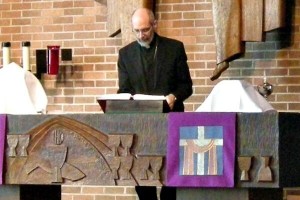“What do Lutherans believe about the ‘the Last Days’”?
Rev. Bond Haldeman
 Almost every Sunday we confess our faith in the words of the Apostles’ Creed or the Nicene Creed. We state our belief in “the resurrection of the body, and the life everlasting,” and claim that Jesus “will come to judge the living and the dead.” In the last few weeks of November and during the season of Advent our Sunday readings often revolve around the themes of the “Lord’s Day,” the resurrection from the dead, and the Parousia, Jesus’ “coming” again.
Almost every Sunday we confess our faith in the words of the Apostles’ Creed or the Nicene Creed. We state our belief in “the resurrection of the body, and the life everlasting,” and claim that Jesus “will come to judge the living and the dead.” In the last few weeks of November and during the season of Advent our Sunday readings often revolve around the themes of the “Lord’s Day,” the resurrection from the dead, and the Parousia, Jesus’ “coming” again.
There can be great confusion about these things, in part because there are so many ideas about them from other denominations. We have Premillennialism, in a number  of variations, which speaks of a time of tribulation preceding the second coming of Christ followed by one-thousand years of “sabbath” before the final judgement. Talk of “the rapture” is sometimes a part of this view, and this was the perspective adopted by the Left Behind fiction of a few years ago. On the other hand, we have the varieties of Postmillennialism, which speaks about Christ’s second coming and the last judgment after one-thousand years of faith revival or Christian theocracy.
of variations, which speaks of a time of tribulation preceding the second coming of Christ followed by one-thousand years of “sabbath” before the final judgement. Talk of “the rapture” is sometimes a part of this view, and this was the perspective adopted by the Left Behind fiction of a few years ago. On the other hand, we have the varieties of Postmillennialism, which speaks about Christ’s second coming and the last judgment after one-thousand years of faith revival or Christian theocracy.
In contract to the previous ideas, Lutherans, along with Roman Catholics and Eastern Orthodox Christians, adopt what might be described as Amillennialism, asserting a non-literal-thousand-years (a symbolic number) between Christ’s first and second coming. Our beliefs are summarized in the statements of the Creeds. Similarly, the Augsburg Confession states that Lutherans:
Teach that at the consummation of the world Christ will appear for judgment, and will raise up all the dead; He will give to the godly and elect eternal life and everlasting joys, but ungodly men and the devils He will condemn to be tormented without end. … They condemn also others who are now spreading certain Jewish opinions, that before the resurrection of the dead the godly shall take possession of the kingdom of the world, the ungodly being everywhere suppressed. (CA XVII)
Lutherans have generally seen attempts to adopt a literal thousand-years or to sort out a time-table as a misreading of Scripture. For instance, we read in Revelation 20:2, “He [an angel] seized the dragon, that ancient serpent, who is the Devil and Satan, and bound him for a thousand years.” But John of Patmos is recounting a spiritual vision of heavenly events throughout this chapter of Revelation. Heavenly time it seems is not earthly time, as Second Peter reminds us, “with the Lord one day is like a thousand years, and a thousand years are like one day” (3:8). Further, Jesus himself declares, “About that day and hour no one knows, neither the angels of heaven, nor the Son, but only the Father. For as the days of Noah were, so will be the coming of the Son of Man” (Mt. 24:36-37).
We assert that Jesus will come again in glory, revealed to all people, there will be a resurrection of the dead through the power of God, and there will be at that same time the final judgment of all people to eternal punishment or eternal life (Mt. 25:46). All talk of the Last Days can seem strange and scary, but we attempt to keep it as simple as the Creeds and hear the Gospel of Salvation. Our hope for eternal life comes through our faith in Jesus Christ by which we are saved. Cling fast to Jesus Christ who is the Son of God and the Savior of all who believe!
Yours in Christ,


